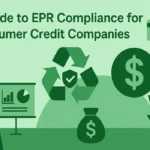As India pushes toward a circular economy, Extended Producer Responsibility (EPR) has emerged as a cornerstone of environmental policy. In 2025, regulatory expectations have increased significantly, and businesses across multiple industries must understand the EPR framework to stay compliant—and competitive.
Whether you’re new to EPR or looking to streamline your compliance process, this article breaks it down into a step-by-step guide that simplifies implementation without compromising on detail.
Step 1: Identify Applicable Waste Categories
The first step is to determine if your business produces or deals with products that generate post-consumer waste. These commonly fall under six regulated categories:
-
E-Waste
-
Plastic Waste
-
Battery Waste
-
Used Tyres
-
Used Oil
-
Hazardous Waste
Each category has its own set of guidelines and compliance procedures governed by CPCB (Central Pollution Control Board).
Step 2: EPR Registration on CPCB Portal
Once you’ve identified applicable categories, your business must:
-
Register on the CPCB’s EPR portal (https://cpcb.nic.in)
-
Submit required documents including product details, PAN, GST, and company incorporation certificates
-
Apply for EPR Authorization by selecting the relevant waste category
Note: Failing to register or operating without EPR authorization is a legal offense.
Step 3: Set Waste Collection Targets
After registration, CPCB assigns you waste collection targets based on:
-
Quantity of products sold/imported/manufactured
-
Waste generation estimates
-
Past compliance records
These targets are typically phased out over a 3–5 year timeline and increase progressively.
Step 4: Partner with Authorized Recyclers
Here’s where many businesses falter. You cannot meet your waste targets by informal or unregistered recycling methods. You must:
-
Work with CPCB-authorized recyclers or PROs (Producer Responsibility Organizations)
-
Ensure every kilogram of waste collected is traceable
-
Obtain valid recycling certificates for documentation and annual reporting
At TEN R Sustainability LLP, we provide businesses with a ready network of verified recyclers, helping you meet targets without the headache of sourcing and verifying partners.
Step 5: Fulfill Annual Reporting Obligations
Each year, you must submit:
-
Proof of collection & disposal (recycler certificates)
-
Performance report against targets
-
Updated product information (if applicable)
This report is submitted online via the CPCB portal and must be timely and accurate to avoid penalties or de-registration.
Step 6: Stay Updated with Policy Changes
In 2025, EPR rules are evolving faster than ever. New categories are being introduced (like textiles and multi-layered packaging), and penalty structures are more stringent. Businesses must:
-
Attend CPCB updates and webinars
-
Subscribe to regulatory newsletters
-
Work with consultants like TEN R Sustainability LLP for proactive compliance
Conclusion
EPR isn’t just a legal mandate—it’s an opportunity to strengthen your brand’s sustainability image, contribute to the planet, and streamline your operations for the future.
With this step-by-step guide, you’re now equipped to start or upgrade your EPR journey in 2025.
Need help implementing EPR?
Let TEN R Sustainability LLP guide you through every step. Contact us
📍 TEN R SUSTAINABILITY LLP, ALT F 101, 2ND FLOOR, MR-01, NH-19, CRRI, OKHLA, NEW DELHI – 110044
📩 info@10rsustainability.com
🌐 www.10rsustainability.com





